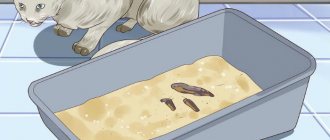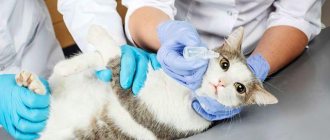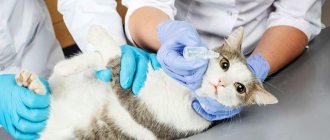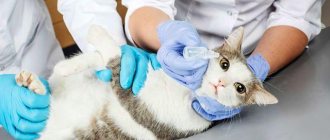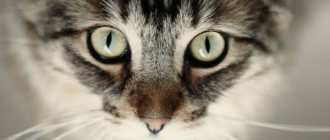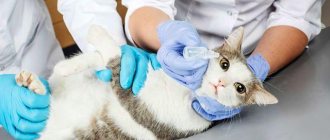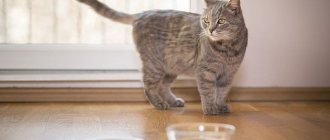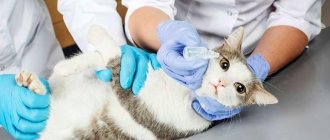A cat's lip ulcer may be caused by Jacobs disease. The disease is similar to herpes rashes on the human lip. More often, the disease affects cats that have reduced immunity.
Also, purebred cats, especially the British breed, are more often susceptible to the disease. Jacobs disease is manifested by defects in the skin, most often an ulcer on the upper or lower lip, but with extensive damage, defects in the integrity of the mucous membrane of the cheeks and abdominal skin are possible.
Symptoms of Jacobs disease
First, a red spot appears on the lip; as a rule, at this stage the disease is not noticeable to the owner.
After a few days, the spot begins to grow, ulcers appear that burst and become wet.
However, the general condition of the cat has not changed. Activity and appetite are maintained. The ulcer on the lip does not itch and does not bother the animal. However, the disease is not as safe as it seems at first glance.
- Firstly, an ulcer on a cat’s lip is a sign of a malfunction of the immune system.
- Secondly, Jacobs ulcers can contribute to the development of cancerous growths such as sarcoma and fibroids.
The cat's upper lip is swollen photo
Indeed, some remedies help both humans and animals such as cats equally well. But in some cases, veterinary drugs developed specifically for animals are required. In addition, it is necessary to make a correct diagnosis: the symptoms of many diseases are similar, and tests cannot be done without. So it is strictly not recommended to treat your pet yourself.
The following painful conditions can cause swelling on a cat's upper lip:
- Insect, snake bite. A cat that has free access to the outdoors enjoys practicing its hunting skills. Sometimes the animal lacks dexterity, and the potential victim manages to bite the hunter. The venom of an insect or snake not only causes severe swelling, but is also dangerous: you need to urgently show your pet to a veterinarian. Unfortunately, not many owners know what to do if a cat is bitten by a wasp or other stinging insect.
- Flea dermatitis. Exoparasites cause a lot of trouble for their owner. When a cat bites a flea, particles of excrement and saliva land on the lip and can cause severe irritation and swelling. However, the presence of fleas in a pet is completely insufficient for a final diagnosis.
- Fracture or bruise. These injuries are often accompanied by bruising or swelling. An active pet can hit itself at home if it does not calculate the trajectory of its flight from the windowsill to the closet. But fractures most often occur in free-ranging animals.
- Allergy. This is one of the most common reasons why a cat has a swollen upper lip. The matter is complicated by the difficulty of diagnosis: the provoking factor is not easy to identify, and besides, infection often penetrates into the affected area. A striking example is eosinophilic ulcer, which has long been considered a symptom of a variety of infections. It has now been precisely established that the cause of this phenomenon is allergy. “Wandering” swelling is another symptom of allergy. First, the animal’s ear may swell; after a few hours, the swelling creeps onto the cheek, then onto the lip, and so on. Eating store-bought food is a more common cause of allergies than is commonly thought. It is also believed that dry food crumbs can get stuck between the hairs around the mouth and cause irritation and swelling. If you are prone to food allergies, it is better to feed your pet natural food: chicken heads, necks, poultry, offal and lean beef - all raw. Another cause of swelling can be an allergy to toilet filler. Those at risk are desperate diggers and neat people who carefully mask the traces of their delicate affairs. All kinds of cat shampoos, as well as household chemicals, often provoke allergies. Substances contained in the leaves of many indoor plants cause an allergic reaction in cats. Allergy treatment is always long-term, complex and selected strictly individually.
- Oral diseases. Diseases of the gums and teeth are almost always accompanied by swelling of the tissues surrounding the source of inflammation. In some cases, the face swells so much that even the most “patient” owners begin to worry about the life of their pet.
- Viral infections. Viral infections can cause symptoms in the form of swelling.
- Burns. It is possible that the cat's upper lip is swollen due to a burn. The animal might become interested in the electric stove or heater that was just turned off. A cat can also get an electrical burn from chewing on wires. For the safety of your pet, it is advisable to limit access to the stove and hide the wiring.
- Fungal infections. Such diseases may also be accompanied by edema.
- Abscess. Or an abscess can develop anywhere, including on the upper lip. The abscess requires urgent surgical intervention, and after surgery the animal needs daily very painful procedures to clean the wound. The sooner your pet gets to the veterinarian, the easier the healing process will be.
- Neoplasms. At first, the tumor may be modest in size and not bother your pet in any way. If the neoplasm is benign and does not tend to grow, you can leave the swelling alone. However, it could be cancer: an accurate diagnosis can only be made in a veterinary clinic.
The pet’s face is always “in full view” from the owner, but the onset of the disease may not be noticed. As a preventive measure, it is advisable to regularly examine your pet’s oral cavity, not let him go outside, and use household chemicals less often.
Related publications:
What to do if your cat scratches its ears and shakes its head
Why does a cat shake his head?
What can cause a cat's tail to hang?
Rectal prolapse in cats: treatment, professional measures…
The main causes of Jacobs disease
Unfortunately, there is no information about the true causes of this disease. There are several theories that exist in veterinary science.
One of the hypothesized versions of the occurrence of an ulcer on a cat’s lip is a viral etiology. There have been cases where antibodies to the leukemia virus were found in the blood of a cat with an ulcer on the lip. But this is more likely due to low immunity, and not to a collision with the leukemia virus. The second assumption is an allergic origin.
The lip ulcer in Jacobs disease consists of many eosinophils. And eosinophils are produced in excessive quantities when an allergen enters the animal’s body.
Another assumption is the presence of ectoparasites in the cat, such as fleas or ticks. In this case, an ulcer on the lip occurs as an allergic reaction to the saliva of parasites.
Also, a predisposing factor to the formation of Jacobs ulcer is the use of plastic bowls. If this disease recurs, it is better to change the bowls to metal ones.
Diagnosis is made based on clinical signs.
Also, to assess the general condition of the cat, you will need to donate blood for a general clinical analysis. To identify the cause of a lip ulcer, you need to be tested for particularly dangerous infections in cats, which include the leukemia virus.
In some cases, a biopsy may be required.
It is worth differentiating the disease from calcivirosis, a viral infection of cats that manifests itself as multiple ulcers in the oral cavity.
The cat's lower lip is swollen: associated symptoms
Regardless of the cause of inflammation, swelling develops around the lip. The skin begins to peel, turns red, and ulcerations appear.
The cat has difficulty eating, as well as the following accompanying symptoms:
- loss of appetite or refusal to eat due to pain while eating.
- profuse drooling;
- resistance when the owner tries to examine the mouth and aggressive rumbling;
- bad breath;
- swelling of the muzzle due to inflamed salivary glands;
- the tongue is hyperemic or has a dirty gray coating on it;
- the animal is losing weight;
- the coat loses its shine and becomes disheveled.
Treatment of a cat's lip ulcer
Treatment is complex, in uncomplicated cases it comes down to the use of immunocorrection drugs, corticosteroids, and local treatments. Treatment must be timely and under the supervision of a veterinarian. In this way, it is possible to avoid dangerous complications.
Prices for appointments in our network of veterinary clinics
| Name of veterinary services | Unit | Price, rub |
| ⭐ Initial appointment | 1 animal | 400 |
| ⭐ Repeated appointment | 1 animal | 250 |
| Initial appointment with a specialist | 1 animal | 1100 |
| Consultation without an animal | — | 550 |
| Consultation with a doctor based on test results | 1 PC. | 400 |
| Weighing animals | 1 animal | For free |
| Additional fixation for aggressive animal behavior | 1 animal | 700 |
All our Veterinary Clinics:
For any suggestions regarding the site: [email protected]
|
